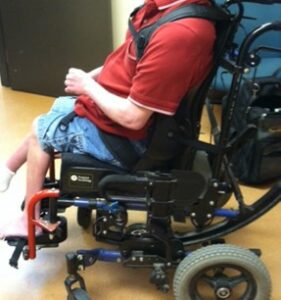Dynamic Seating and the Restraint Debate
Michelle L. Lange, OTR/L, ATP/SMS
There are times when a wheelchair seating and mobility team, after careful evaluation and problem-solving, makes specific recommendations – only to hear that these well thought out interventions may be considered to be a restraint. This problem is not limited to Long Term Care facilities – as a pediatric therapist, I hear these concerns more often than I would like.

A pelvic positioning belt is often misconstrued as a Restraint.
Restraints
So just what is considered a Restraint? To be fair, the Restraint Debate is well intentioned. Years ago, and too often today, clients were ‘restrained’ to control bad behavior, to reduce the amount of required caregiver intervention, or even as punishment. Restraints may include physical restraint (such as securing a person to bed or a wheelchair) or chemical restraint (such as sedating medications). None of this is acceptable – ever.
Unfortunately, many of the strategies used in wheelchair seating systems are misconstrued as a restraint and team members, particularly in restraint-free settings, may protest. It is critical to understand exactly what the pertinent regulations state and what is required so that these interventions can indeed be used – even in restraint-free environments.
Dynamic Seating and Restraints
What does this have to do with Dynamic Seating? Well, for a Dynamic Back to work properly, the pelvis must remain in as neutral a position as possible. This is partially accomplished by using an appropriately angled pelvic belt. Pelvic belts are often misconstrued as a restraint.
Client movement which results in movement of a Dynamic Footrest typically requires the foot to be secured to the footplate. Otherwise, this movement would result in the foot moving off of the footplate rather than activating this dynamic component. The feet may be secured using some type of strapping, including toe straps, ankle straps, ankle huggers, and shoeholders with straps. As the feet are secured to the footplates, this is often misconstrued as a restraint.
What do the Regulations Say? And what can we do about it?
OBRA regulations apply to facilities receiving federal funding, though other settings may adopt these regulations, interpret them, and add to them. OBRA regulations state: “Restraints may only be imposed, 1) to ensure the physical safety of the resident or other residents, and 2) only upon written order of a physician that specifies the duration and circumstances under which restraints are to be used.” Our documentation must explain how a seating component ensures physical safety (i.e. the client will not fall out of the wheelchair) and a physician order is required.
Documentation must also justify the clinical indicators for each seating component. Most regulations look at the intent of the component to determine whether this is being used as a restraint. For example, “a pelvic positioning belt is being recommended to maintain a neutral pelvic position which, in turn, will facilitate a more upright trunk and head position.”
The Omnibus Budget Reconciliation Act of 1987 (OBRA) regulations cite that the individual’s preference regarding use of a restraint must be met, if possible (Social Security, 1987). An individual may prefer specific seating interventions (that may be misconstrued as a restraint) for functional purposes or to minimize the risk of injury. If the individual requests such intervention, it can be used despite other policies that may be in place.
So, what is the Bottom Line?
It is possible to use a Dynamic Back with a pelvic belt and Dynamic Footrests while securing the feet to the footplates – even in Restraint-free environments. We have several resources that can help you as you strive to provide the most appropriate interventions. These resources also address other restraint definitions.
Are you having difficulty implementing appropriate dynamic seating interventions due to the Restraint Debate? Contact us – we would love to help!
